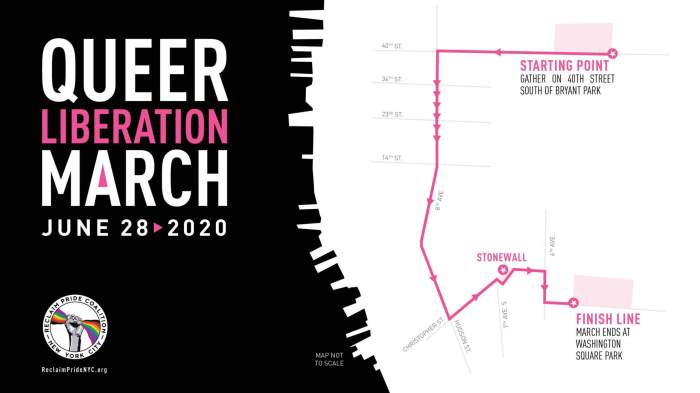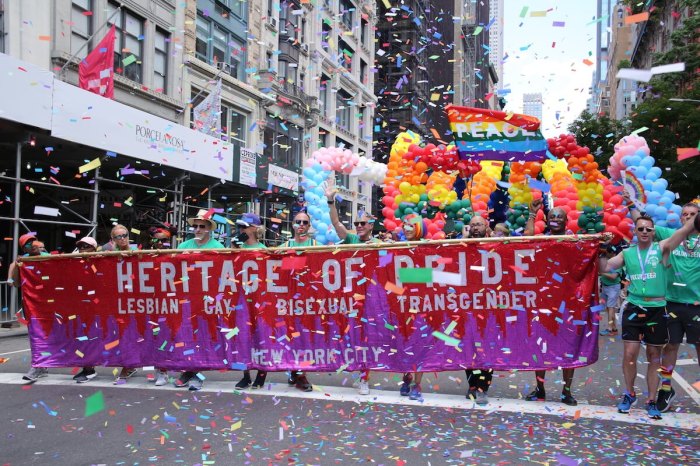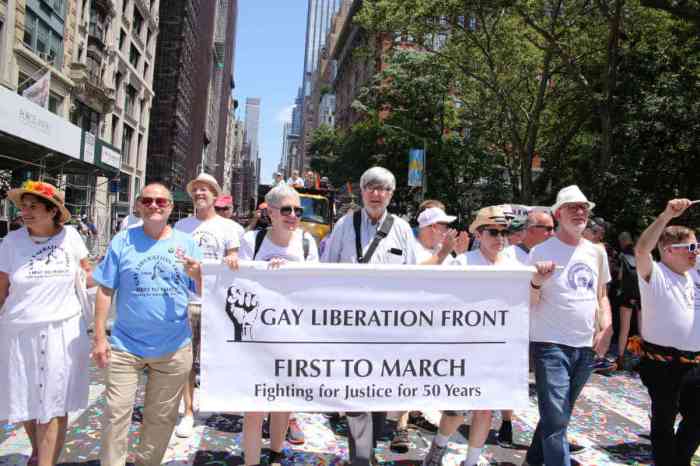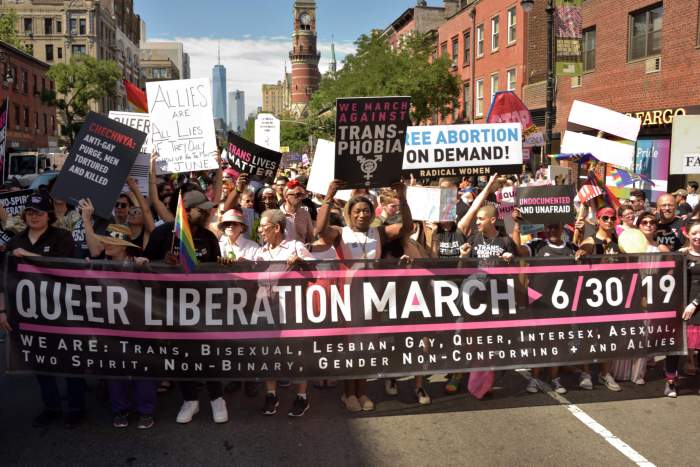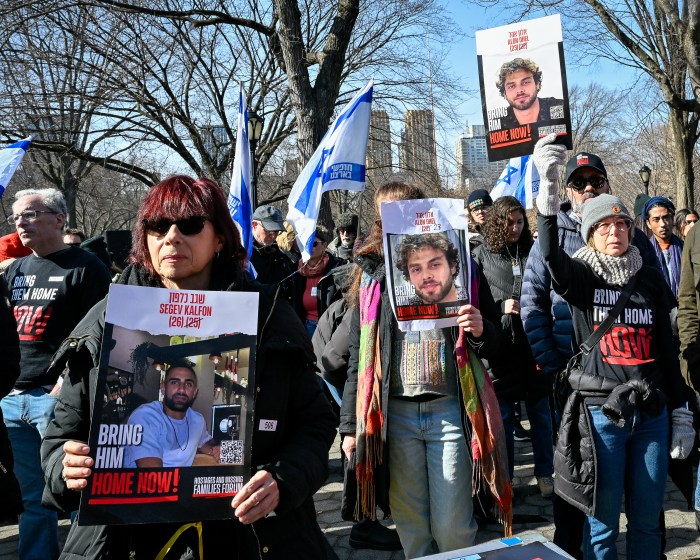A crowd of 5,000 refused to join in the Stonewall 25 March up First Avenue past the United Nations and instead marched up Fifth Avenue from the Village past St. Patrick’s Cathedral which was guarded by a phalanx of top NYPD brass, including Commissioner William Bratton. | JIM O’CONNOR
Moments before Charlie Cochrane, an NYPD sergeant, spoke at a 1981 City Council hearing in support of legislation that would ban discrimination based on sexual orientation, he had to listen to a vice president from the Patrolmen’s Benevolent Association oppose the bill and assert that there were no gay cops in New York City.
“I am very proud of being a New York policeman,” Cochrane, then 38, said at the hearing. “And I am equally proud to be gay.”
Writing in a 2016 Gay City News article about Cochrane, Andy Humm, who was among the activists who fought for that legislation for 15 years, wrote, “Except for the bill’s final passage in 1986, there was never a more dramatic moment in the long history of that fight.”
Cochrane, who died in 2008, was the subject of controversy again in 1982, but this time within the LGBTQ community after the Christopher Street Liberation Day Committee (CSLDC), which was then the producer of the city’s annual Pride Parade and Rally, chose him as a speaker at the rally.
“We didn’t know Charlie, who turned out to be a nice guy,” said David France, the documentary filmmaker, who was among the opponents of Cochrane’s appearance. “It was like a Black Lives Matter thing. It just didn’t make any sense that we would be celebrating a cop. We were just as often attacked by cops as we were by homophobes.”
Over 48 years, NYC’s Pride events often at the center of controversy
France, who was representing a group called the Lavender Left, was joined by Gina Quattrocchi of the Coalition Against Racism, Anti-Semitism, Sexism and Heterosexism, Ian Daniels of the Revolutionary Socialist League, and Lee Grimmet of Black and White Men Together. They were joined by Dykes Against Racism Everywhere.
They were “members of a left-wing minority” in CSLDC, they wrote in a 1982 letter to Womanews, a newspaper, and they were “calling for a militant/ political contingent in this year’s lesbian and gay pride day march.”
Republican Ronald Reagan had won his first term in the White House just 18 months before. There were “increased attacks” on the LGBTQ community, they wrote, that were part of a “general growing reactionary climate in this country” and they were “waging a fight within CSLDC to maintain the traditions of the 1969 Stonewall Rebellion and to link the struggles of lesbian and gay men with those of other oppressed peoples.”
Ultimately, Cochrane spoke at the rally.
This was not the first dispute within the LGBTQ community over the parade, rally, or festival nor would it be the last. The annual events have regularly been contested over their meaning, the route, or their content. It is accurate to say that arguing about New York City’s annual Pride events, which commemorate the 1969 Stonewall riots that mark the start of the modern LGBTQ rights movement, is as much a part of the tradition as holding the events themselves.
Once in front of St. Pat’s, the 1994 alternative march sat-in on Fifth Avenue to protest the homophobia of the Catholic Church’s hierarchy. | JIM O’CONNOR
The first parade came in 1970 and was organized by Craig Rodwell, who opened the Oscar Wilde Memorial Bookshop in 1967, the first LGBTQ bookstore, and Fred Sergeant. Gay Scene, a newspaper, wrote, “The entire event was orderly and there were no incidents and is believed to be the largest gay event in history.”
Gay City News found no evidence that the 1971 and 1972 events were controversial, though Rodwell complained following the 1971 parade that getting groups to “swallow their personal organizational pride” and come together was difficult. The 1973 rally certainly was controversial.
The modern understanding of a video showing Sylvia Rivera, who died in 2002, speaking at the rally, which was held in Washington Square Park, is that she was railing against the assimilationist gays in the audience who had denied Rivera a place in the community’s history. The story is more complex.
That year, the parade began at Columbus Circle and traveled down Seventh Avenue to the park. Mama Jean DeVente, an activist, was the grand marshal. Apparently feeling slighted, Rivera took the banner for the Street Transvestite Action Revolutionaries, a group that Rivera founded, and jumped into the parade ahead of DeVente. Two parade marshals were summoned — “whose clothing and throats Sylvia tore,” Michael Schiavi wrote in “Celluloid Activist: The Life and Times of Vito Russo,” a biography of that central figure in LGBTQ history. Once at the park, Rivera stormed the stage and commandeered the microphone to deliver a loud, three-minute assault on the movement that was greeted with a mix of boos, cheers, and applause.
Lee Brewster, a drag performer who marched with the Queens Liberation Front that year, suggested that another controversy explains Rivera’s conduct. Upon learning that drag performers would appear at the rally, the Lesbian Feminist Liberation (LFL) group wrote a critique of drag that Jean O’Leary, a former nun, read from the rally stage, also to boos, cheers, and applause, after Rivera spoke.
“When men impersonate women for reasons of entertainment, of profit, they insult women,” O’Leary said, as seen in a video found on Vimeo. “We support the right of every person to dress in the way that she or he wishes, but we are opposed to the exploitation of women by men for entertainment or profit. Men have been telling us who we are all our lives.”
An angry Brewster, who died in 2000, took the microphone and told the crowd, “You go to bars because of what drag queens did for you… and let these bitches tell us we’re offensive,” Schiavi wrote. Brewster threw his tiara into the crowd saying, “Gay liberation, screw you.”
In a Drag magazine article about the 1973 march and rally titled “Drags & TV’s Join the March,” the anonymous author speculates that “certain men-hating lesbian factions incited transvestite Sylvia Rivera to disrupt” the rally. The theory, which was not supported by any evidence, was that since political speeches were banned that year, once Rivera spoke, Russo, who was the emcee, was forced to allow O’Leary to read her statement. Rivera’s “takeover” involved “the cuting [sic] up of several committee members,” the article noted.
“We don’t condone what Sylvia did, a violent takeover was uncalled for,” Brewster, the magazine’s publisher, said in the article. “When Miss O’Leary then took the stage and read her statement denying the cross dresser the right to employment as a cross dresser, she singled us out to spew her hatred and rhetoric on.”
Take Back Pride, founded by Jamie McGonnigal, debuted in that years Pride Parade. | DUNCAN OSBORNE
Misogyny in the LGBTQ rights movement continued to be an issue. LFL withheld its endorsement of the 1975 and 1976 marches because they were noted more for their “gaudy floats” than “Lesbian visibility.” LFL endorsed the 1977, 1978, and 1979 marches.
Misogyny and other issues resulted in two rallies taking place in Central Park in 1980, following several years of emerging divisions.
In 1979, the LGBTQ community held its first national March on Washington. The Northeast region organizers of that march had been active in the anti-war movement and were generally engaged with the American left. They also belonged to CSLDC and to a national network that was created post-march to facilitate communications among groups. Some of those same members were also active in the Coalition for Lesbian and Gay Rights (CLGR), formed in 1977 to pursue anti-discrimination legislation in New York City and the State Legislature. The Northeast region organizers were angered when New York City groups, including CSLDC, endorsed the national march only late in the process.
When CLGR, which had over 30 member groups, organized a meeting of New York groups in the spring of 1980 to discuss state legislation, LFL and other members voiced unhappiness when they learned that David Thorstad and Bob Rhodes, two members of the North American Man/ Boy Love Association (NAMBLA), which was founded in 1979, were CSLDC members and active at the gathering. Thorstad had been a member of CLGR beginning in 1978 but had stepped down in the spring of 1979. Misogyny and race also sparked disagreement at the 1980 meeting.
“I find the attacks against LFL and CLGR quite illuminating,” Juanita Ramos, one of the Northeast region organizers, wrote in a 1980 open letter about the infighting laid bare by the 1979 March on Washington organizing and the 1980 conference. “Coming from predominantly white gay male groups these attacks signify to me the unwillingness of the white male gay movement in this city to surrender any of their power to those lesbians with whom they claim to be ‘willing’ to work. This is where the crux of the CLGR/ March on Washington controversy lies.”
By the time of the 1980 Pride Rally, the CLGR faction, calling themselves the Lesbian and Gay Pride March Organizing Committee, stood where that year’s march was entering Central Park and invited people to attend their alternative rally. Soon, CLGR had pulled out of CSLDC and the annual Pride organizing efforts.
Occupy Wall Street marches in the 2012 parade. | DUNCAN OSBORNE
In a 1982 fundraising letter from Tony Gambino, CSLDC’s co-coordinator that year, to Long Island’s East End Gay Organization for Human Rights, Gambino wrote, “I am also aware that there has [sic] been some bad feelings between our two organizations stemming in part from the fiasco of the 1980 March and Rally. In the two years that I’ve been co-coordinator of CSLDC a lot of changes have been made… The principal change has been to bring in a great many new members (individuals and groups) who are considered ‘centrist’ or ‘mainstream.’ The radicals who once controlled CSLDC have either left or splinterized.”
Gambino was soon out as well.
In March 1984, the Manhattan Community Athletic Association, a bowling league, accused him of taking $2,838 in MCAA funds and giving it to CSLDC, the New York City News, an LGBTQ newspaper, reported that year. He also allegedly took $3,760 from the Stonewall Awards Foundation and gave it to CSLDC. By this point, all these organizations found themselves in some financial peril.
“I remember going to a meeting in the Spring of ‘84 and we suddenly learned we had $19 in the bank,” said Matt Foreman, a longtime LGBTQ activist. “There was a mad scramble to raise money.”
The Gay Male S/ M Activists, which shut down in 2009, bailed out CSLDC with a $6,000 fundraiser.
“That was enough to do what we had to do,” Foreman said. “I think we only had one portable toilet.”
In 1985, Foreman and Candida Scott Piel, also a longtime LGBTQ activist, decided the community “needed a break from the old brand” and incorporated Heritage of Pride (HOP), which has produced New York City’s annual Pride Parade and related events since then. The festival, which was produced by a separate organization for years, was folded into HOP in 1992. Despite persistent rumors that the festival had some Mafia link, HOP learned that if it was mobbed up, it was among the least profitable mob ventures.
“We always thought that it should be part of the parade,” Foreman said. “Basically, when Heritage of Pride took it over, it was barely making any money… That was a completely opaque, no board of directors kind of organization.”
A contingent in support of Chelsea Manning, then in military prison and still known as Bradley Manning, in the 2013 Pride Parade. | DUNCAN OSBORNE
HOP became the organization that it is today in 1986 and 1987. The pier dance, now called Pride Island, that closes out the weekend was added as were the Lavender Line on Fifth Avenue and the fireworks that come at the end of the dance. That era also saw the first major sponsors for the parade. The disputes slowed, but they did not stop.
In 1994, the 25th anniversary of the Stonewall riots, Stonewall 25, which was not HOP, ran the parade and chose to put the march on First Avenue passing the United Nations building to reflect the international meaning of that year’s event. Some New Yorkers, who knew that CSLDC had fought for seven years to get a permit to march on Fifth Avenue and understood that route to represent the community achieving a certain status, organized an alternative march that began in the West Village and went up Fifth Avenue to Central Park where the 1994 rally took place.
The NYPD declined to arrest the 5,000 people who participated in the alternative march and let it proceed unobstructed by traffic or police. But William Bratton, the police commissioner then, and the NYPD made their views known by placing a phalanx of police officers in front of St. Patrick’s Cathedral, by then a target of LGBTQ anger over the Catholic Church’s stridently homophobic posture. Bratton was on the cathedral’s steps as the march went by as was John Miller, then the department’s chief spokesperson and now the NYPD’s deputy commissioner for intelligence and counterterrorism.
This year, the march route was changed to begin in Chelsea and travel south on Seventh Avenue, east on Christopher and Eighth Streets, then north on Fifth Avenue ending at 29th Street. The new route is controversial in the LGBTQ community and among Chelsea residents.
The corporate presence in the march has been more visible, though community groups and non-profits have always constituted the great majority of the contingents in the parade. In 2010, Jamie McGonnigal founded Take Back Pride, which was a “movement to put the politics back into the parade, the march back in the march,” he said then. That group marched that year.
In 2018, complaints about the corporations and police in the parade and how the parade is policed took on a greater intensity as a group of activists with long ties to the LGBTQ and other movements organized as the Reclaim Pride Coalition. The Coalition asked that members of the Gay Officers Action League (GOAL) march without uniforms and weapons, a request that was denied by GOAL and HOP, and that the police presence at the march be reduced, a request that was effectively denied. The Coalition has been permitted to organize a resistance contingent in this year’s parade.
The complaints about that corporate presence in the parade have grown louder over time. Even Foreman has second thoughts.
“We wanted to make it more joyous,” he said. “In hindsight, I’m not sure we were right… Now, I feel like there are too many floats, too many corporate floats.”






